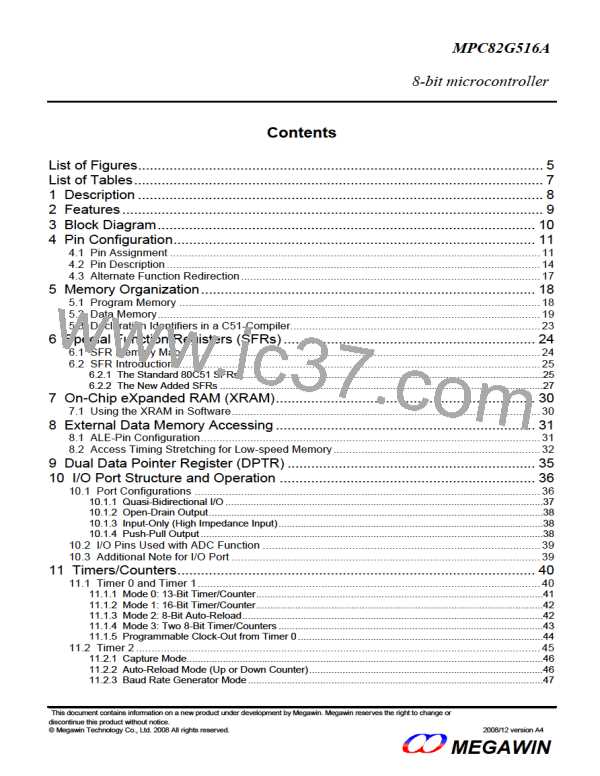P2M1 (Address=96H, Port 2 Mode Register 1, Reset Value=0000,0000B)
7
6
5
4
3
2
1
0
P2M1.7 P2M1.6 P2M1.5 P2M1.4 P2M1.3 P2M1.2 P2M1.1 P2M1.0
P3M0 (Address=B1H, Port 3 Mode Register 0, Reset Value=0000,0000B)
7
6
5
4
3
2
1
0
P3M0.7 P3M0.6 P3M0.5 P3M0.4 P3M0.3 P3M0.2 P3M0.1 P3M0.0
P3M1 (Address=B2H, Port 3 Mode Register 1, Reset Value=0000,0000B)
7
6
5
4
3
2
1
0
P3M1.7 P3M1.6 P3M1.5 P3M1.4 P3M1.3 P3M1.2 P3M1.1 P3M1.0
P4M0 (Address=B3H, Port 4 Mode Register 0, Reset Value=0000,0000B)
7
6
5
4
3
2
1
0
P4M0.7 P4M0.6 P4M0.5 P4M0.4 P4M0.3 P4M0.2 P4M0.1 P4M0.0
P4M1 (Address=B4H, Port 4 Mode Register 1, Reset Value=0000,0000B)
7
6
5
4
3
2
1
0
P4M1.7 P4M1.6 P4M1.5 P4M1.4 P4M1.3 P4M1.2 P4M1.1 P4M1.0
10.1.1 Quasi-Bidirectional I/O
Port pins in quasi-bidirectional mode are similar to the standard 8051 port pins. A quasi-bidirectional port can be
used as an input and output without the need to reconfigure the port. This is possible because when the port
outputs a logic high, it is weakly driven, allowing an external device to pull the pin low. When the pin outputs low,
it is driven strongly and able to sink a large current. There are three pull-up transistors in the quasi-bidirectional
output that serve different purposes.
One of these pull-ups, called the “very weak” pull-up, is turned on whenever the port register for the pin contains
a logic “1”. This very weak pull-up sources a very small current that will pull the pin high if it is left floating. A
second pull-up, called the “weak” pull-up, is turned on when the port register for the pin contains a logic “1” and
the pin itself is also at a logic “1” level. This pull-up provides the primary source current for a quasi-bidirectional
pin that is outputting a 1. If this pin is pulled low by the external device, this weak pull-up turns off, and only the
very weak pull-up remains on. In order to pull the pin low under these conditions, the external device has to sink
enough current to over-power the weak pull-up and pull the port pin below its input threshold voltage. The third
pull-up is referred to as the “strong” pull-up. This pull-up is used to speed up low-to-high transitions on a quasi-
bidirectional port pin when the port register changes from a logic “0” to a logic “1”. When this occurs, the strong
pull-up turns on for two CPU clocks, quickly pulling the port pin high.
The quasi-bidirectional port configuration is shown in Figure 10-1. A quasi-bidirectional port pin has a Schmitt-
triggered input for noise suppression.
Figure 10-1. Quasi-Bidirectional I/O
37
MPC82G516A Data Sheet
MEGAWIN

 MEGAWIN [ MEGAWIN TECHNOLOGY CO., LTD ]
MEGAWIN [ MEGAWIN TECHNOLOGY CO., LTD ]